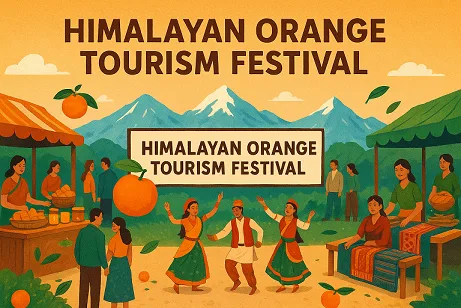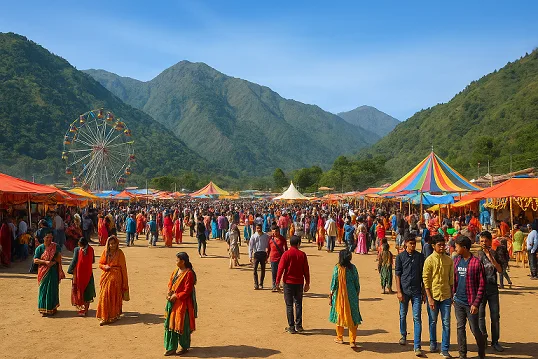What Was the Silk Route?
The Silk Road was not a single path but a series of interconnected trade routes that spanned from China through India, Persia, and all the way to Europe. It served as a bridge for the exchange of goods, cultures, and ideas between diverse civilizations for over a millennium. The name “Silk Road” was coined by the German geographer Ferdinand von Richthofen in the 19th century, named after the famous Chinese silk that was traded along the route.
Significance of the Silk Route in India in
India played a central role in the Silk Road network, particularly because of its geographical location. The Himalayas acted as a natural gateway for traders traveling between the Indian subcontinent and Central Asia, including the Middle East and China. Indian goods like spices, textiles, and gems were in high demand, while the exchange of knowledge and religion contributed to the cultural richness of the region.
Routes of the Silk Road in the Indian Himalayas
The Indian subcontinent was an essential hub along the Silk Road, with many critical routes passing through the Himalayan foothills. Several mountain passes and towns became key trading points where merchants and travelers from different parts of the world met.
1. Niti Pass and Mana Pass (Uttarakhand)
These two passes in Uttarakhand were important gateways in the Himalayan region. Niti Pass, located in Chamoli district, linked Tibet to India, allowing the exchange of silk and spices. Similarly, Mana Pass, near Badrinath, was another significant trade route leading from India to Tibet. It also served as a religious pilgrimage route, with many Buddhist monks traveling through these passes to spread Buddhism in Tibet.
2. Ladakh – The Crossroads of Central Asia and India
Ladakh, known as the “Land of High Passes,” was an important center along the Silk Road. The Karakoram Pass and Zanskar Valley were key routes connecting India, China, and Central Asia. Traders from Kashmir and India traveled to Central Asia, and vice versa, through these passes, exchanging silk, tea, spices, and precious stones. The city of Leh, the capital of Ladakh, became a bustling market town where these goods were exchanged. It was also a hub for Buddhist monasteries, spreading Buddhist teachings from India to Tibet.
3. Spiti and Kinnaur (Himachal Pradesh)
The remote valleys of Spiti and Kinnaur in Himachal Pradesh were essential stops for traders along the northern route. Kinnaur, in particular, was famous for its apple orchards and traditional handicrafts, which were traded along with silk. Spiti Valley, often referred to as “Little Tibet,” shared strong cultural ties with Tibet and was a route for Buddhist monks who spread the religion throughout the region.
4. The Trade City of Kashmir
The Kashmir Valley was a crucial point on the Silk Road, acting as a melting pot of various cultures. The route from Central Asia passed through Kashmir, linking the northwestern plains of India with Tibet, China, and Persia. Srinagar, the capital of Kashmir, became a vibrant center for the exchange of silk, wool, spices, and fine Kashmiri shawls. It was also an important Buddhist and later a Muslim cultural center.
The Role of Religion in the Silk Route through the Himalayas
One of the most fascinating aspects of the Silk Road through India was the spread of religions. The Himalayan passes acted as routes for Buddhist monks to travel from India to Tibet and China. It is believed that Buddhism spread to Central Asia and later to China, partly due to the monks’ use of the Silk Road.
In fact, some of the most famous Buddhist monasteries in Ladakh, Spiti, and Kinnaur were built by these monks. The influence of Hinduism, Zoroastrianism, and later Islam also spread along these routes.
Cultural and Economic Impact
The cultural exchange that took place along the Silk Road in the Indian Himalayas was unparalleled. People from different civilizations interacted, leading to the exchange of ideas, technology, art, and literature. Some of the notable impacts include:
Art: The Silk Road brought with it new styles of art and architecture, such as Buddhist cave paintings and temples in the Himalayan regions.
Language: The movement of traders and monks led to the spread of languages, and new scripts and dialects developed along the route.
Technology: Innovations like paper, printing, and gunpowder were exchanged through the Silk Road, many of which found their way to India.
Cuisine: The exchange of spices and food products transformed Indian cuisine. The introduction of noodles, tea, and dried fruits can be traced back to the Silk Road.
Decline of the Silk Road
The decline of the Silk Road began in the 15th century due to various reasons, including political instability, the rise of maritime trade, and the Mongol invasions. The Himalayan routes also fell into disuse as the region became more politically fragmented. However, their legacy continues to shape the cultures and economies of regions like Ladakh, Spiti, and Kinnaur today.
Silk Route Today: A Cultural Heritage
Today, the Himalayan region where the Silk Road once thrived is still a culturally rich area with vibrant Buddhist monasteries, historical forts, and scenic mountain passes. Many of the old trade routes are now popular for trekking, mountain biking, and tourism. These areas attract travelers not just for their natural beauty but also to experience the cultural richness left behind by the ancient trade routes.
Conclusion
The Silk Road through the Indian Himalayas was a crucial part of one of the most significant historical trade routes in the world. It connected people, ideas, and cultures across vast distances, and its legacy continues to influence the region today. Whether it was silk, spices, religions, or art, the Himalayan Silk Road played an instrumental role in shaping the cultural landscape of India, China, and Central Asia.
By understanding the history of this route, we can appreciate not just the trading legacy, but also the profound impact it had on the development of human civilization.
By – Mohit Bangari









